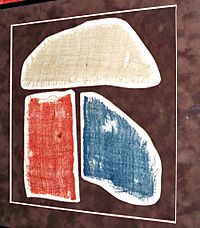Star-Spangled Banner (flag) facts for kids
The Star-Spangled Banner, also called the Great Garrison Flag, is a very famous American flag. This huge flag flew over Fort McHenry in Baltimore Harbor during a big battle in the War of 1812.
After the battle on September 14, 1814, Francis Scott Key saw the flag still flying. This inspired him to write a poem called "Defence of Fort M'Henry". These words were later set to a popular song tune. In 1931, this song officially became the national anthem of the United States.
A "garrison flag" is a special, extra-large flag. The U.S. Army flies these flags on Sundays, holidays, and other important days. The Star-Spangled Banner is unique because it has fifteen stripes. It's the only official American flag with more than thirteen stripes.
Contents
History of the Flag
Before an attack on Baltimore, Fort McHenry was prepared for defense. Major George Armistead, the fort's commander, wanted a giant flag. He wanted the British to see it clearly from far away.
General John S. Stricker and Commodore Joshua Barney ordered two large flags. The biggest one was the Great Garrison Flag. It was the largest battle flag ever flown at that time. They also ordered a smaller "Storm Flag." This flag was stronger and better for bad weather.
Local flagmaker Mary Young Pickersgill sewed this flag in 1813. The government paid her $405.90 for her work.
Flag Design Details
Mary Pickersgill made the flag from cotton and dyed English wool. Her daughter, two nieces, and an African American helper assisted her. The flag has fifteen red and white stripes. It also has fifteen white stars on a blue background.
The two extra stars and stripes were added for Vermont and Kentucky. These states had recently joined the United States. The stars are arranged in rows of three. At that time, new states meant adding both stars and stripes.
The flag was originally 30 feet tall and 42 feet wide. Each stripe was 2 feet wide. Each star measured about 2 feet across. Over time, parts of the flag were given away as souvenirs. This, along with wear and tear, made the flag smaller. Now, it measures 30 feet tall and 34 feet wide. It also has only fourteen stars. The fifteenth star was given away, and its location is unknown.
The Battle and the Poem
The flag flew over Fort McHenry during the British attack on September 12, 1814. About 5,000 British soldiers and 19 ships attacked Baltimore. On September 13, the British ships began shelling Fort McHenry. They fired continuously for 25 hours in heavy rain.
The British ships could not get past the fort into the harbor. So, they ended their attack. On the morning of September 14, the battered flag was still flying. This showed that Fort McHenry was still in American hands.
Francis Scott Key, an American lawyer, saw the battle from a British truce ship. When he saw the flag still flying at dawn, he was inspired. He wrote a poem called "Defence of Fort McHenry." This poem was later set to music and renamed "The Star-Spangled Banner." A part of it became the United States National Anthem.
The Flag at the Smithsonian Museum

The Star-Spangled Banner flag became a very important historical item. Major Armistead, who was promoted, kept the flag for many years. His grandson, Eben Appleton, inherited it in 1878.
In 1907, Appleton lent the flag to the Smithsonian Institution. In 1912, he officially gave it to them. Today, the flag is permanently displayed at the National Museum of American History. This museum is part of the Smithsonian in Washington, D.C..
The flag has been carefully restored multiple times. A big restoration project started in 1999. Experts examined the flag closely using science. They cleaned it and made a plan to keep it safe for a long time. This restoration finished in 2008.
Since 2008, the flag has been on display in a special two-story room. It lies at a 10-degree angle in dim light to protect it. The museum has an exhibition called "The Star-Spangled Banner: The Flag that Inspired the National Anthem." Visitors can see the flag clearly in its protected environment.
The museum also created an online exhibition. You can explore the flag's details closely online. You can also listen to an audio tour and hear the song played on old instruments.
Images for kids
-
Star Spangled Banner Flag on display at the Smithsonian's National Museum of American History, around 1964.
-
Mary Pickersgill and her nieces sewing the flag. Artist's drawing by Robert McGill Mackall, 1962.
-
Francis Scott Key watching the flag the morning after the battle. Artist's drawing by Edward Percy Moran, 1913.
-
President George W. Bush (center) sees the flag when the National Museum of American History reopened in 2008.






